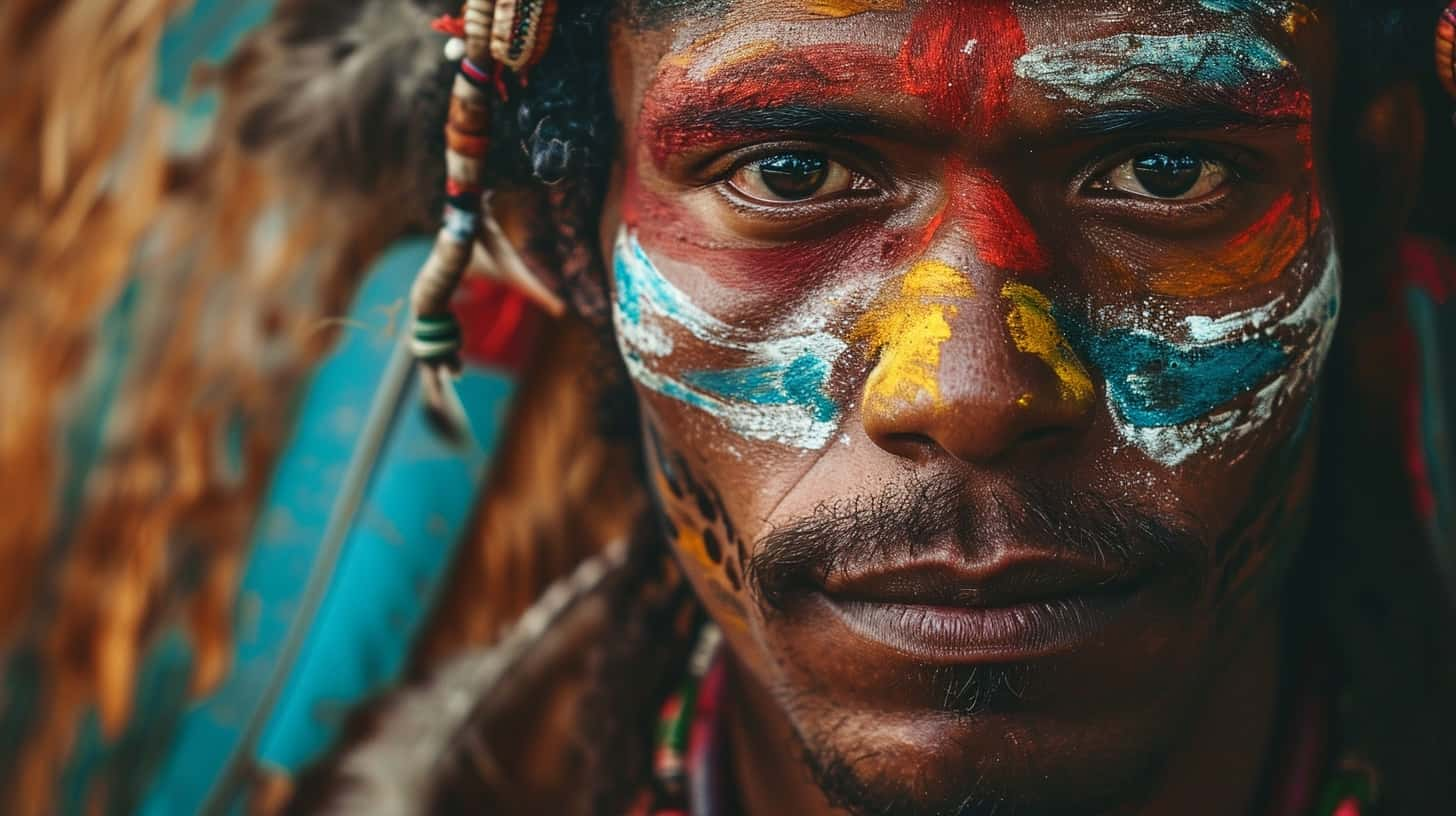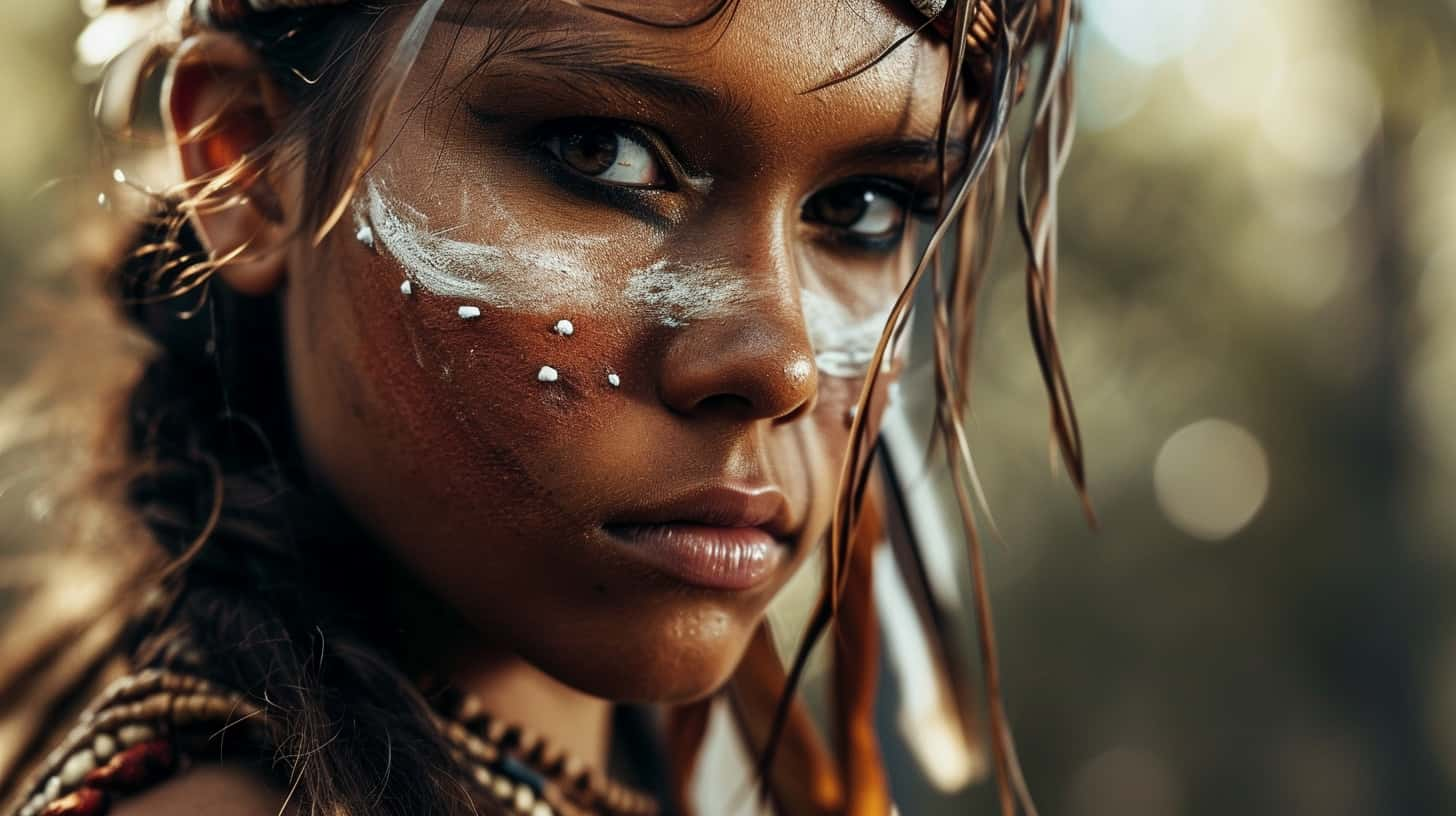Did you know that the right frame can make an artwork up to 40% more visually appealing?Framing plays a pivotal role. Understanding the significance of framing in relation to Aboriginal art not only enhances our appreciation for its cultural value but also ensures that these invaluable pieces are displayed with the respect they deserve. The perfect frame has the power to elevate and accentuate the visual impact of each artwork, breathing new life into every stroke and symbol.
In this post, we delve into how framing is not just about protecting art but also about honoring its roots and traditions. Join us as we explore how different frames can enhance our connection with these artworks while respecting their historical context.

Understanding Aboriginal Art and Its Cultural Significance
Importance of Aboriginal Art
Aboriginal art holds immense meaning as it reflects the deep cultural heritage and spiritual beliefs of Indigenous communities. Through vibrant paintings, intricate dot patterns, and striking designs, Aboriginal artists convey stories that have been passed down for generations. These artworks are not merely decorative; they hold profound significance in preserving traditions and connecting to the land. For instance, symbols like concentric circles represent meeting places or waterholes, while wavy lines depict rivers or paths traveled by ancestors.
The use of traditional symbols and motifs in Aboriginal art is a way for artists to communicate their connections to the land and their ancestral history. Each symbol has a specific meaning deeply rooted in Indigenous culture. For example, an artwork featuring kangaroo tracks might tell a story about hunting expeditions or survival skills passed down through oral traditions. By understanding these symbols, we gain insight into the rich narratives embedded within each piece of art.
Recognizing Cultural Significance
When framing Aboriginal art, it’s crucial to recognize its cultural significance beyond aesthetic appeal. The way we present these artworks should honor their origins and respect their storytelling purpose. Improper framing can detract from the essence of the artwork or even misrepresent its narrative.
To showcase our respect for this cultural legacy when framing Aboriginal art pieces, we must consider using materials that align with traditional practices whenever possible. Opting for natural wood frames over modern synthetic ones can contribute to maintaining authenticity while also enhancing the overall presentation.
Taking into account regional variations in artistic styles is essential when choosing frames for different pieces of Aboriginal art. For instance, bark paintings from Arnhem Land may require unique framing techniques compared to acrylic dot paintings from Central Australia due to differences in materials used and artistic conventions.

Selecting the Right Frame for Aboriginal Art
Factors to Consider
When framing Aboriginal art, we need to consider several factors to ensure that the frame complements the artwork without overpowering it. The material, color, and style of the frame play a crucial role in enhancing the visual appeal of the artwork while respecting its cultural significance. For instance, if we have an intricately designed piece with earthy tones and natural textures, opting for a simple wooden frame can accentuate its organic beauty without distracting from its essence.
Selecting a frame that aligns with the aesthetic and cultural context of Aboriginal art is essential. We must be mindful of not only how our choice affects the visual presentation but also how it respects and reflects the cultural heritage embedded within each piece. For example, when framing a traditional dot painting representing Dreamtime stories, choosing a frame with colors or patterns reminiscent of nature or indigenous symbols can help maintain authenticity and reverence for the artwork’s origins.
Style Alignment
The style of both the artwork and the frame needs to harmonize in order to create a balanced visual impact. Whether it’s a contemporary acrylic on canvas or a traditional bark painting, ensuring that our chosen frame style resonates with that of the artwork is pivotal. If we have an abstract modern piece characterized by bold lines and vibrant hues, considering a sleek float frame can provide an elegant yet unobtrusive border that allows focus on the art itself.
In addition:
- Opt for frames made from natural materials such as wood or bamboo to complement artworks featuring organic elements.
- Avoid ornate or heavily embellished frames when framing minimalist Aboriginal art pieces as they may overshadow their simplicity and elegance.
- Consider consulting with Indigenous artists or experts who can offer valuable insights into selecting culturally appropriate frames for specific types of Aboriginal art.
Matting and Mounting Techniques for Aboriginal Art
Importance of Proper Matting
The matting plays a crucial role in protecting the artwork. By using an acid-free mat, we can prevent damage to the surface of the art over time. This is essential because direct contact with glass or glazing can harm the delicate nature of many Aboriginal artworks.
Using a mat also creates a visual space between the artwork and the glazing, preventing any moisture from being trapped against the surface. When selecting mats for framing, we should always opt for acid-free options to ensure long-term preservation.

Mounting Techniques
Mounting techniques such as hinging or floating are important considerations based on each artwork’s specific requirements. For instance, hinging involves attaching the artwork to a backing board using archival hinges that allow it to expand and contract with changes in humidity. On the other hand, floating involves securing an artwork without any visible means of support.
Both these methods offer unique benefits; hinging allows for easy removal if conservation work is required, while floating creates a contemporary and unobtrusive presentation style that suits certain types of Aboriginal art.
Ensuring Longevity
The use of suitable mounting techniques not only enhances the aesthetic appeal but also ensures longevity by minimizing potential damage caused by traditional adhesive mounts or direct contact with backings.
By carefully considering our choicesWe contribute significantly towards preserving these culturally significant pieces for future generations to appreciate.
Glazing Options for Preserving Aboriginal Art
UV-Filtering Glazing
Using conservation-grade materials is crucial. We can opt for UV-filtering glazing, which shields the artwork from harmful light exposure that causes fading and damage. This type of glazing acts as a barrier, protecting the vibrant colors and intricate details of the art.
UV-filtering glazing ensures that our Aboriginal art remains vivid and captivating for years to come. It’s like giving our artwork a shield against the sun’s harmful rays, preserving its beauty and cultural significance.
Non-Glare Options
Another essential consideration when framing Aboriginal art is non-glare options. These types of glazing minimize reflections, making it easier for us to appreciate every stroke and detail in the artwork without distractions. By reducing glare, non-glare options enhance visibility, allowing us to immerse ourselves fully in the richness of Aboriginal art.
Non-glare options are like magic windows that eliminate unwanted reflections, ensuring that nothing comes between us and the mesmerizing stories depicted in each piece of Aboriginal art.

Consultation with Professional Framers
Seeking guidance from professional framers is invaluable when choosing glazing options for preserving Aboriginal art. They possess expertise in assessing the specific needs of each artwork and recommending suitable glazing solutions tailored to its preservation requirements.
Professional framers are like trusted guides on our journey to protect and showcase our cherished Aboriginal artworks. Their knowledge helps us make informed decisions, ensuring that we choose the best glazing option to safeguard these cultural treasures.
Displaying Aboriginal Art with Appropriate Hanging Techniques
Suitable Hanging Hardware
When framing Aboriginal art, it’s crucial to use appropriate hanging hardware that can securely support the weight of the framed artwork. We need to ensure that the chosen hardware is strong enough to hold the frame and prevent it from falling off the wall. For heavier pieces, we might consider using heavy-duty hooks or D-rings, while lighter artworks may only require basic picture hooks.
Some artworks may have specific hanging requirements due to their size or shape. For instance, large canvases with stretcher bars might need additional support in the form of wire across the back for even weight distribution.
Consideration for Wall Placement
We must carefully consider where we hang our framed Aboriginal art. Factors such as lighting and humidity levels play a significant role in preserving these precious pieces. When choosing a location, we should avoid areas with direct sunlight exposure as UV rays can cause fading and damage over time.
Furthermore, excessive moisture can be detrimental to these artworks; therefore, we should steer clear of hanging them in places prone to high humidity levels like bathrooms or kitchens. It’s important not to place them near air vents or radiators which could subject them to fluctuations in temperature and humidity.
Protective Measures
To safeguard our Aboriginal art from potential damage caused by environmental factors like light and moisture, there are protective measures we can take. One option is using UV-filtering glass when framing our artwork; this helps reduce the harmful effects of ultraviolet light exposure on colors and materials.
Moreover, maintaining an optimal indoor climate by controlling humidity levels through dehumidifiers or air conditioning units can contribute significantly towards preserving these valuable pieces for generations to come.
Choosing Between Rolled Canvas or Linen for Framing
Flexibility in Framing Options
We often face the decision of whether to use rolled canvas or linen. Opting for rolled canvas provides us with flexibility in framing options. We can choose how we want the artwork to be presented, whether stretched over a frame or left unmounted.
Rolled canvas allows us to explore different framing possibilities, such as floating the artwork within a frame or showcasing it without glass. This way, we have the freedom to adapt the presentation based on our preferences and the specific requirements of each piece of art.
We also have the option to stretch the rolled canvas at a later time if we initially decide not to do so. This flexibility is particularly beneficial when dealing with various sizes and shapes of artworks, giving us room for experimentation before making any permanent decisions.
Stability and Durability
On the other hand, choosing linen for framing offers us a more stable surface for our aboriginal art pieces. Unlike canvases made from other materials like cotton or polyester, linen is less prone to warping and sagging over time. Its sturdy nature ensures that our artwork remains well-supported and preserved within its frame.
Linen’s durability makes it an excellent choice for preserving valuable aboriginal artworks that may require long-term protection against environmental factors such as humidity and temperature changes. By selecting linen as our framing material, we prioritize safeguarding these culturally significant pieces while ensuring their longevity.
Considering Artwork Requirements
When deciding between rolled canvas and linen for framing aboriginal art, it’s crucial to consider the specific requirements of each individual artwork. For instance:
- If an artwork has intricate details near its edges that should remain visible even when framed, opting for rolled canvas might be more suitable.
- Conversely, if an artwork needs extra support due to its size or weight distribution across its surface area, choosing linen could provide better stability.
Protecting Aboriginal Canvas Art in Humid Climates
Preserving Artworks
When framing Aboriginal art for humid climates, we must consider the challenges posed by moisture. High humidity can lead to mold growth and warping of canvas artworks. To preserve these valuable pieces, it’s crucial to use techniques and materials that are resistant to moisture.
We need to ensure that the framing materials we choose provide a protective barrier against moisture. Opting for UV-protective glass or acrylic can shield the artwork from both ultraviolet rays and excess humidity. Using acid-free mats and backing boards can prevent moisture absorption, safeguarding the integrity of the art piece.
It’s important to remember that even if an artwork is not directly exposed to water, high levels of humidity alone can still pose a threat. Mold thrives in damp environments, making it essential for us to take proactive measures when selecting framing materials.
Monitoring Humidity Levels
Regular monitoring of indoor humidity levels is vital in maintaining a stable environment for framed Aboriginal canvas art. By utilizing hygrometers or similar devices, we can keep track of fluctuations in relative humidity within our living spaces.
If we notice an increase in moisture, there are various steps we could take to mitigate its impact on our framed artworks. For instance, using dehumidifiers or air conditioners during periods of high humidity helps regulate indoor moisture levels effectively.
In addition to technological aids like dehumidifiers, incorporating natural remedies such as silica gel packets within the frame package can also absorb excess moisture from the surrounding air. This extra layer of protection ensures that our Aboriginal artworks remain shielded from potential harm caused by fluctuating environmental conditions.
Key Considerations When Choosing an Art Framer
Experience
When choosing a framer for framing Aboriginal art, it’s crucial to look for someone experienced in handling and framing this specific type of artwork. We want to ensure that the framer understands the cultural significance and unique requirements of Aboriginal art. For instance, they should be familiar with the delicate nature of natural ochres used in traditional Indigenous paintings.
It’s essential to find a framer who has previously worked with similar pieces and is knowledgeable about the appropriate techniques for preserving and presenting Aboriginal art. This expertise can make a significant difference in how well the artwork is protected over time.
Material Quality
We need to check if the framer uses archival-quality materials that meet conservation standards when framing Aboriginal art. The use of such materials ensures that our artwork will be protected from deterioration caused by environmental factors or poor framing practices.
Archival-quality materials are specifically designed to prevent damage from light exposure, moisture, and acidity. By using these high-quality materials, we can have peace of mind knowing that our Aboriginal art will remain intact and vibrant for years to come.
Recommendations
As part of our search for a reliable framer, we should ask for recommendations or reviews from other art collectors or Indigenous artists who have had their Aboriginal art framed professionally. Hearing about others’ experiences can provide valuable insights into the quality of work offered by different framers.
Cost Considerations for Framing Aboriginal Art
Factors Affecting Costs
When framing Aboriginal art, we need to consider several factors that can impact the overall cost. The size of the artwork plays a significant role in determining the framing expenses. Larger pieces generally require more materials, such as glass and matting, which can increase the cost. The materials used for framing, including the type of glass and quality of wood or metal frames, influence pricing. Moreover, complexity in design or customizations like special mat shapes or multiple openings may lead to higher costs.
Another crucial aspect is balancing our budget constraints with the need for proper preservation. We want to ensure that our chosen framer not only offers competitive prices but also maintains high standards in preserving and protecting Aboriginal art.
Seeking Multiple Quotes
To make an informed decision and manage our budget effectively, it’s essential to seek quotes from multiple framers. By doing so, we can compare not only the prices offered by different framers but also evaluate the services they provide. Some framers might offer additional services such as UV-protective glass or museum-quality archival materials at slightly higher prices compared to others who provide standard options.
When obtaining quotes from various framers, we should inquire about their experience in handling and framing Aboriginal art specifically. This ensures that they understand the unique requirements for preserving this type of artwork while considering our financial limitations.
Conclusion: Preserving the Essence of Aboriginal Art Through Framing
We’ve delved into the intricate world of framing Aboriginal art, understanding its cultural significance, and the techniques to preserve its essence. By selecting the right frame, matting, glazing, and display techniques, we not only protect the artwork but also honor its heritage. The journey of exploring the nuances of framing Aboriginal art has been enlightening, and it reinforces our commitment to preserving and respecting diverse artistic traditions.
As we continue our artistic adventures, let’s remember the importance of cultural preservation and responsible art appreciation. Let’s actively seek out opportunities to support and learn from indigenous artists and their communities. Our collective efforts can contribute to a more inclusive and culturally rich art world.
Frequently Asked Questions
Is framing Aboriginal art different from framing other types of art?
Yes, framing Aboriginal art requires a deep understanding of its cultural significance and the appropriate techniques to preserve its essence. The choice of materials, matting, and glazing are crucial in showcasing the artwork respectfully.
What are some key considerations when choosing an art framer for Aboriginal art?
When selecting an art framer for Aboriginal art, it’s essential to look for expertise in handling Indigenous artwork, knowledge of preservation techniques specific to this type of art, and a strong reputation within the community for respecting cultural sensitivities.
How can I protect Aboriginal canvas art in humid climates?
In humid climates, protecting Aboriginal canvas art involves using proper sealing techniques on the frame to prevent moisture damage. Controlling indoor humidity levels through dehumidifiers or air conditioning can help maintain the integrity of the artwork.
What are some cost considerations for framing Aboriginal art?
The cost of framing Aboriginal art depends on factors such as the choice of materials, complexity of preservation techniques required, and customization options. It’s important to balance budget constraints with ensuring that proper methods are used to honor the cultural significance of the artwork.
Why is it important to select the right frame for displaying Aboriginal art?
Choosing a suitable frame is vital because it not only enhances the visual appeal but also respects and preserves the cultural significance of Indigenous artworks. A well-selected frame complements and protects the piece while allowing its unique qualities to shine through.
Talise is a talented writer and an expert in her field. Her unique perspective and insights enrich our content with depth and authenticity. With a wealth of knowledge and a strong connection to the subjects she writes about, Talise crafts engaging and informative articles that resonate with our readers. Her dedication to bringing Indigenous culture and wisdom to light is truly commendable.










